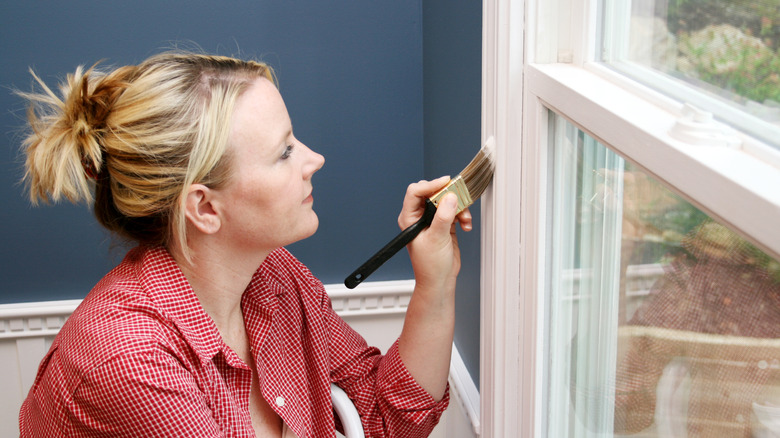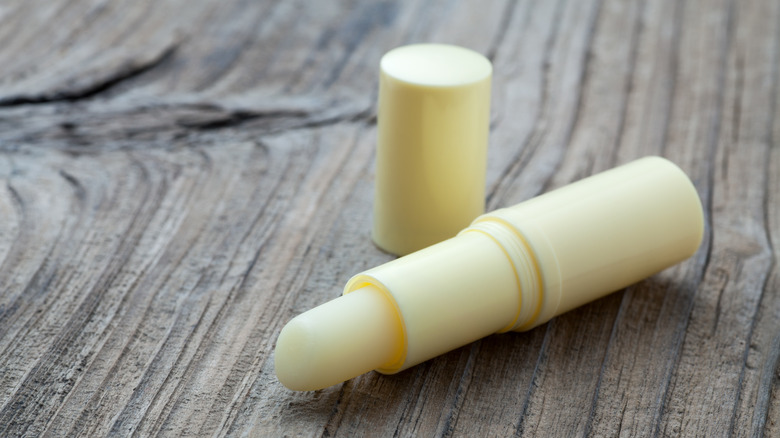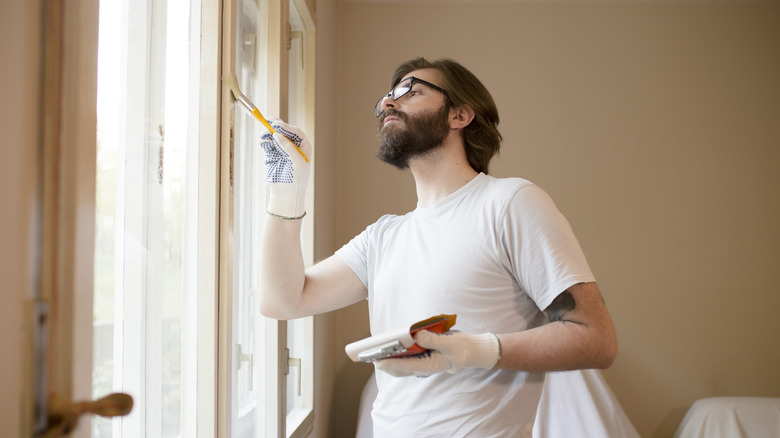Why You'll Want A Tube Of Chapstick On Hand When Painting
Painting is a popular go-to for homeowners to add life to a space and increase home value since it's inexpensive and usually doesn't require the help of a professional to complete. Whether a novice or a professional, everyone is bound to make a mistake while painting the surfaces around their home. Even the smallest and most precise brushes can lead to smudging, and not even painter's tape is completely foolproof against accidents. In the chance painter's tape is unavailable, or if you're looking for an alternative, a simple solution may be available inside your purse. Applying chapstick along the edges of glass windows or other surfaces before beginning a paint job allows you to easily wipe off excess paint in the event you accidentally meander outside of the lines.
Using chapstick instead of sticky tape has its advantages. It doesn't call for the precision that tape does when being applied, making it easy to work with. You may also find the chapstick hack to work even better than traditional painter's tape since tiny bits of paint can still easily squeeze underneath strips of applied tape and may be a pain to scrape off in the aftermath. Taking only seconds to administer, chapstick is a common household find that can greatly reduce the time and effort needed to clean up after major or minor paint jobs. Let's explore this hack in greater depth and compare how chapstick measures up to other paint-removing alternatives.
How it works
Unlike painter's tape, which acts as a temporary barrier protecting window panes, baseboards, and other accessories from collecting paint, chapstick is applied with the intention of making mistakes that will need to be cleaned up after your paint job is complete. Apply chapstick over the surfaces you would normally cover with painter's tape, like window sills, casing, and door hinges. The chapstick will catch any excess drips or smudges, acting as a layer of separation between the surface and the paint. Use a cotton swab to administer the product for a more precise application. After painting, go over the chapstick-applied areas with a dry paper towel or rag to wipe up any remnants of paint with little effort. If any chapstick residue remains after wiping, use a glass cleaner to achieve a deeper clean.
Painter's tape works best when needing to protect straight edges. Contrarily, the chapstick method is perhaps most useful when working with complex designs consisting of curved edges or intricate patterns with hard-to-reach corners. But, even chapstick has its limitations. There's always the possibility of misjudging your mess-ups before starting, which could lead to having to scrape the dried paint off with no assistance, potentially causing harm to the surface underneath. In other words, using chapstick is a worthy alternative if you're running short on time, but using multiple paint removal techniques in tandem may offer the best results.
Other items to use as substitutes
While chapstick is an effective tool to make a messy paint job look professionally done, it isn't the only household item you can use to clean up edges. If you don't have any spare chapstick on hand before starting a paint job, try using Vaseline in its place. The product's slippery consistency also prevents applied paint from sticking to unwanted surfaces. Another paint-removing hack that's considered even more user-friendly than traditional tape is paper strips. Cut an unused sheet of paper into strips, douse the strips in water, and place them along the edges of your windows, as you would arrange pieces of painter's tape. Wring them free of any excess water before applying, and secure them using a dry and clean paintbrush. Removing the strips after the paint has dried is much easier than removing the paper's sticky counterpart, considering you won't have to worry about scrubbing bits of adhesive off the glass after the fact.
If you're willing to invest in higher-quality equipment, look no further than a temporary protective coating or masking liquid. Available online and in some stores that sell hardware and home improvement tools, temporary coating comes in liquid form and hardens into a gel substance once applied. After the coating solidifies, finish the paint job and peel the gel off the edges. Some gel may need to be sliced away with a knife or blade, so exercise caution if working with glass or other sensitive surfaces.


